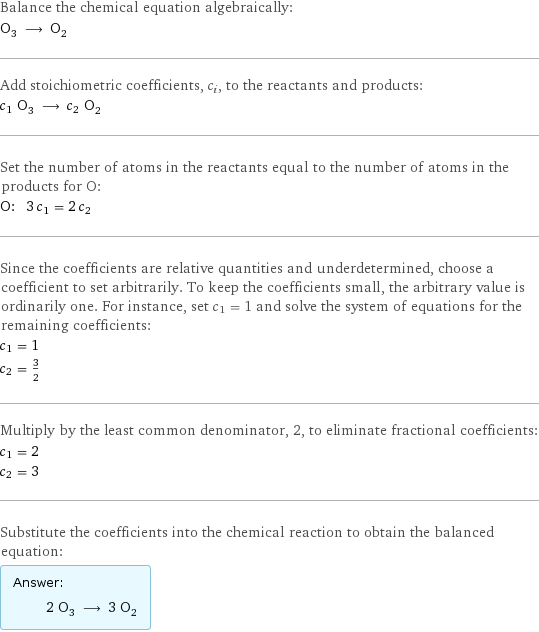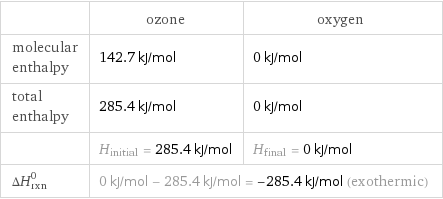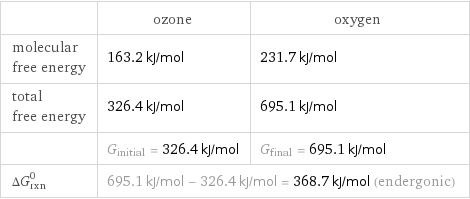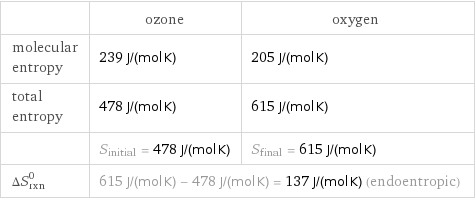Input interpretation

O_3 ozone ⟶ O_2 oxygen
Balanced equation

Balance the chemical equation algebraically: O_3 ⟶ O_2 Add stoichiometric coefficients, c_i, to the reactants and products: c_1 O_3 ⟶ c_2 O_2 Set the number of atoms in the reactants equal to the number of atoms in the products for O: O: | 3 c_1 = 2 c_2 Since the coefficients are relative quantities and underdetermined, choose a coefficient to set arbitrarily. To keep the coefficients small, the arbitrary value is ordinarily one. For instance, set c_1 = 1 and solve the system of equations for the remaining coefficients: c_1 = 1 c_2 = 3/2 Multiply by the least common denominator, 2, to eliminate fractional coefficients: c_1 = 2 c_2 = 3 Substitute the coefficients into the chemical reaction to obtain the balanced equation: Answer: | | 2 O_3 ⟶ 3 O_2
Structures

⟶
Names

ozone ⟶ oxygen
Reaction thermodynamics
Enthalpy

| ozone | oxygen molecular enthalpy | 142.7 kJ/mol | 0 kJ/mol total enthalpy | 285.4 kJ/mol | 0 kJ/mol | H_initial = 285.4 kJ/mol | H_final = 0 kJ/mol ΔH_rxn^0 | 0 kJ/mol - 285.4 kJ/mol = -285.4 kJ/mol (exothermic) |
Gibbs free energy

| ozone | oxygen molecular free energy | 163.2 kJ/mol | 231.7 kJ/mol total free energy | 326.4 kJ/mol | 695.1 kJ/mol | G_initial = 326.4 kJ/mol | G_final = 695.1 kJ/mol ΔG_rxn^0 | 695.1 kJ/mol - 326.4 kJ/mol = 368.7 kJ/mol (endergonic) |
Entropy

| ozone | oxygen molecular entropy | 239 J/(mol K) | 205 J/(mol K) total entropy | 478 J/(mol K) | 615 J/(mol K) | S_initial = 478 J/(mol K) | S_final = 615 J/(mol K) ΔS_rxn^0 | 615 J/(mol K) - 478 J/(mol K) = 137 J/(mol K) (endoentropic) |
Equilibrium constant
![Construct the equilibrium constant, K, expression for: O_3 ⟶ O_2 Plan: • Balance the chemical equation. • Determine the stoichiometric numbers. • Assemble the activity expression for each chemical species. • Use the activity expressions to build the equilibrium constant expression. Write the balanced chemical equation: 2 O_3 ⟶ 3 O_2 Assign stoichiometric numbers, ν_i, using the stoichiometric coefficients, c_i, from the balanced chemical equation in the following manner: ν_i = -c_i for reactants and ν_i = c_i for products: chemical species | c_i | ν_i O_3 | 2 | -2 O_2 | 3 | 3 Assemble the activity expressions accounting for the state of matter and ν_i: chemical species | c_i | ν_i | activity expression O_3 | 2 | -2 | ([O3])^(-2) O_2 | 3 | 3 | ([O2])^3 The equilibrium constant symbol in the concentration basis is: K_c Mulitply the activity expressions to arrive at the K_c expression: Answer: | | K_c = ([O3])^(-2) ([O2])^3 = ([O2])^3/([O3])^2](../image_source/b5e522fb449a34c244d7d06fee8c3383.png)
Construct the equilibrium constant, K, expression for: O_3 ⟶ O_2 Plan: • Balance the chemical equation. • Determine the stoichiometric numbers. • Assemble the activity expression for each chemical species. • Use the activity expressions to build the equilibrium constant expression. Write the balanced chemical equation: 2 O_3 ⟶ 3 O_2 Assign stoichiometric numbers, ν_i, using the stoichiometric coefficients, c_i, from the balanced chemical equation in the following manner: ν_i = -c_i for reactants and ν_i = c_i for products: chemical species | c_i | ν_i O_3 | 2 | -2 O_2 | 3 | 3 Assemble the activity expressions accounting for the state of matter and ν_i: chemical species | c_i | ν_i | activity expression O_3 | 2 | -2 | ([O3])^(-2) O_2 | 3 | 3 | ([O2])^3 The equilibrium constant symbol in the concentration basis is: K_c Mulitply the activity expressions to arrive at the K_c expression: Answer: | | K_c = ([O3])^(-2) ([O2])^3 = ([O2])^3/([O3])^2
Rate of reaction
![Construct the rate of reaction expression for: O_3 ⟶ O_2 Plan: • Balance the chemical equation. • Determine the stoichiometric numbers. • Assemble the rate term for each chemical species. • Write the rate of reaction expression. Write the balanced chemical equation: 2 O_3 ⟶ 3 O_2 Assign stoichiometric numbers, ν_i, using the stoichiometric coefficients, c_i, from the balanced chemical equation in the following manner: ν_i = -c_i for reactants and ν_i = c_i for products: chemical species | c_i | ν_i O_3 | 2 | -2 O_2 | 3 | 3 The rate term for each chemical species, B_i, is 1/ν_i(Δ[B_i])/(Δt) where [B_i] is the amount concentration and t is time: chemical species | c_i | ν_i | rate term O_3 | 2 | -2 | -1/2 (Δ[O3])/(Δt) O_2 | 3 | 3 | 1/3 (Δ[O2])/(Δt) (for infinitesimal rate of change, replace Δ with d) Set the rate terms equal to each other to arrive at the rate expression: Answer: | | rate = -1/2 (Δ[O3])/(Δt) = 1/3 (Δ[O2])/(Δt) (assuming constant volume and no accumulation of intermediates or side products)](../image_source/d670a642d4d22361e4454dab675daea3.png)
Construct the rate of reaction expression for: O_3 ⟶ O_2 Plan: • Balance the chemical equation. • Determine the stoichiometric numbers. • Assemble the rate term for each chemical species. • Write the rate of reaction expression. Write the balanced chemical equation: 2 O_3 ⟶ 3 O_2 Assign stoichiometric numbers, ν_i, using the stoichiometric coefficients, c_i, from the balanced chemical equation in the following manner: ν_i = -c_i for reactants and ν_i = c_i for products: chemical species | c_i | ν_i O_3 | 2 | -2 O_2 | 3 | 3 The rate term for each chemical species, B_i, is 1/ν_i(Δ[B_i])/(Δt) where [B_i] is the amount concentration and t is time: chemical species | c_i | ν_i | rate term O_3 | 2 | -2 | -1/2 (Δ[O3])/(Δt) O_2 | 3 | 3 | 1/3 (Δ[O2])/(Δt) (for infinitesimal rate of change, replace Δ with d) Set the rate terms equal to each other to arrive at the rate expression: Answer: | | rate = -1/2 (Δ[O3])/(Δt) = 1/3 (Δ[O2])/(Δt) (assuming constant volume and no accumulation of intermediates or side products)
Chemical names and formulas

| ozone | oxygen formula | O_3 | O_2 name | ozone | oxygen IUPAC name | ozone | molecular oxygen
Substance properties

| ozone | oxygen molar mass | 47.997 g/mol | 31.998 g/mol phase | gas (at STP) | gas (at STP) melting point | -192.2 °C | -218 °C boiling point | -111.9 °C | -183 °C density | 0.001962 g/cm^3 (at 25 °C) | 0.001429 g/cm^3 (at 0 °C) surface tension | | 0.01347 N/m dynamic viscosity | | 2.055×10^-5 Pa s (at 25 °C) odor | | odorless
Units
